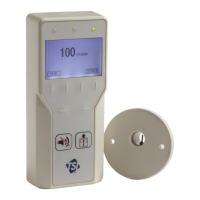Part Two
Diagnostics Menu
The items in the Diagnostic Menu aid in identifying problems the staff may encounter. Upon
entering the Diagnostics Menu, all of the associated outputs hold at their most recent state.
Output can be temporarily changed by entering the item or by pressing the quick keys. No
permanent change occurs with these menu items. All of the associated inputs in the Diagnostics
Menu will continually update in order to monitor their function. The Diagnostics menu is exited by
pressing the ESC soft key. When the Diagnostics menu is exited, the controller returns to its
normal state.
Enter CONTROL OUT menu item in diagnostics menu. A number
between 0% open and 100% open representing the current damper or
venturi valve position will be displayed. Close the damper or venturi
valve fully using the quick keys or entering the CONTROL OUT item and
using the key. Note the position of the control damper or venturi valve.
Open the damper or venturi valve fully using the quick keys or the
key. The damper should have rotated 90 degrees, or the venturi valve
should have moved its full stroke. If the damper rotated less than 85
degrees (or the venturi valve moved less than 90% of full stroke), see
Troubleshooting chart: Control system is not controlling. If the damper or
valve is fully closed when the CONTROL OUT item is 100% open,
change direction of control using CONTROL SIG item in CONTROL
menu.
WARNING: The CONTROL OUT function overrides the face velocity
or flow control signal. Adequate face velocity or flow will
NOT be maintained while in this menu item.
The VEL SENSOR INPUT item verifies that the controller electronics is
receiving a signal from a sidewall sensor. When this item is entered, a
voltage will be indicated on the display. The exact number displayed is
relatively unimportant. It is more important that the displayed number
changes when the velocity changes (blow on sensor, move sash, etc.). If
display does not change, see Troubleshooting chart; “SENSOR ERROR”
flashing on display.
The SHOW FACE VEL item is used to display the current face velocity,
either as measured by a sidewall sensor or calculated from exhaust flow
rate and open sash area.
NOTE: If face velocity does not match actual readings, recalibrate
face velocity.
The FLOW ANALOG INPUT item is used to read the input from the flow
station. When this item is entered, a voltage is indicated on the display.
The exact number displayed is relatively unimportant. It is more
important that the voltage is changing which indicates the flow station is
working correctly.
0 VDC displayed equals zero flow.
10 VDC displayed equals maximum flow.
NOTE: FHM10 monitors and FHC50 controllers can be field
configured so 5 VDC displayed equals maximum flow.

